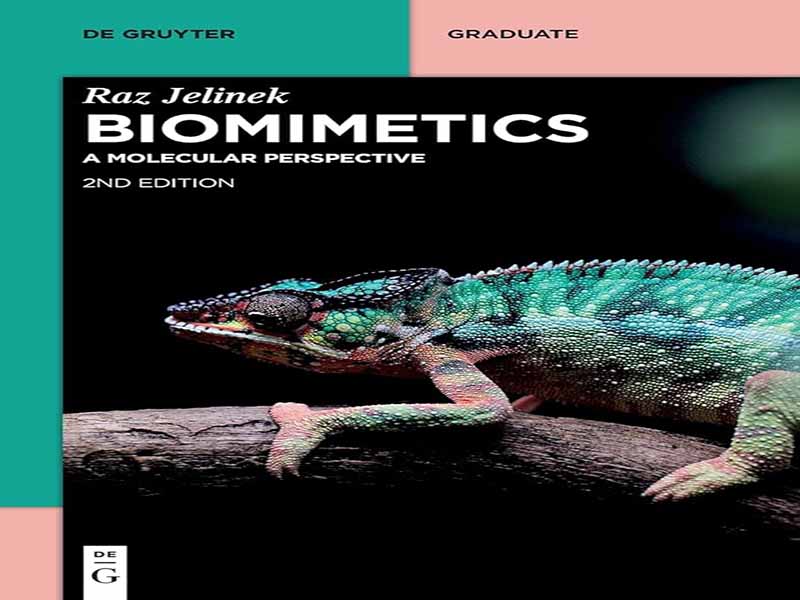- عنوان کتاب: Biomimetics/A Molecular Perspective
- نویسنده: Raz Jelinek
- حوزه: زیست شناسی مولکولی
- سال انتشار: 2021
- تعداد صفحه: 278
- زبان اصلی: انگلیسی
- نوع فایل: pdf
- حجم فایل: 7.95 مگابایت
چگونه می توان “بیومیمتیک” را تعریف کرد؟ این اصطلاح احتمالاً توسط Janine Benyus در کتاب خود “Biomimicry: Innovation Inspired by Nature” در سال 1997 ابداع شد. Biomimicry (از bios، به معنای زندگی، و mimesis، به معنای تقلید) به طور کلی به عنوان “بررسی طبیعت، مدل ها، سیستم ها، فرآیندها و عناصر آن برای تقلید یا الهام گرفتن از آن به منظور حل مشکلات انسانی” تعریف شده است. حل مشکلات انسانی قطعاً یک نیروی محرکه اصلی در این زمینه رو به رشد بوده است، به ویژه با توجه به کاربردهای زیست پزشکی و راه های درمانی برای درمان بیماری ها، که مفاهیم، مولکول ها و فرآیندهای فیزیولوژیکی را از طبیعت به عاریت گرفته اند. با این حال، بیومیمتیک به عنوان یک مفهوم علمی متمایز، تخیل محققان را فراتر از اهداف تولید داروهای بهتر، اندامهای مصنوعی یا محصولات جدید الهامگرفته از زیستی به خود جلب کرده است، بلکه به عنوان پایه و الهامبخشی برای روشهای نوآورانه جدید برای طراحی و درک ماده بر روی آن است. یک سطح عمیق تر هنگام در نظر گرفتن امکانات بیومیمتیک برای پیشرفت دانش و فناوری بشر، با تنوع بسیار زیاد پدیدهها، فرآیندها و مواد طبیعی روبرو میشویم – همه اینها اساساً به دورانی که برای ایجاد تنوع عظیمی از ساختارها و فرآیندهای بیولوژیکی در اطراف ما طول کشیده است، ادغام میشوند. . بنابراین با توجه به “بی صبری” گونه ما کاملاً انتظار می رود که پیشرفت در زمینه “بیومیمتیک” در مقایسه با میلیون ها سالی که تکامل تاکنون طراحی ویژگی های بیولوژیکی جدید و بهبود یافته را از طریق آزمایش و آزمایش دیکته کرده است، بسیار سریعتر رخ دهد. خطا در واقع، برای یک رشته علمی نسبتاً جوان، دستاوردهای علوم بیومیمتیک قابل توجه بوده است. هدف این کتاب ترسیم خطوط کلی فعلی بیومیمتیک به عنوان یک زمینه تحقیقاتی متمایز، کاربردهای عملی و پتانسیل آن است. مهم است که تاکید کنم که من در اینجا به جای جنبه های گسترده سیستم های “مقیاس کلان” مانند پمپ های آب الهام گرفته شده از زیستی، توربین های بادی، “ساختمان های سبز” و بسیاری مفاهیم شگفت انگیز و مفید دیگر، روی سیستم های مولکولی بیومیمتیک تمرکز می کنم. سیستم هایی که خارج از محدوده این کتاب هستند. همچنین، این کتابی درباره الهام گیری کلی تاریخی از دنیای زنده نیست (ایکاروس و ددالوس که پرواز پرنده را تقلید می کنند شامل نمی شود). در عوض، این کتاب بر روی مولکولها، مجموعههای مولکولی، و فرآیندها و مفاهیم مولکولی تمرکز دارد که از زیستشناسی برای حل چالشهای غیربیولوژیکی بهرهبرداری میکنند، یا راهحلهای غیربیولوژیکی را برای مشکلات بیولوژیکی و زیستپزشکی پیادهسازی میکنند. با این وجود، در حالی که سعی کردهام تا حد امکان جنبههای این حوزه بسیار گسترده و متنوع را در بر داشته باشم، به دلایل عملی از فضا و دامنه، موضوعات متنوع حذف شدهاند. من عموماً در مورد رشتههای مرتبط و برجسته که به بیومیمتیکها مربوط میشوند، برای مثال زرادخانه عظیم ترکیبات دارویی که برای تقلید از مولکولهای بیولوژیکی یا تداخل در فرآیندهای بیولوژیکی طراحی شدهاند، بحث نکردم.
How one is to define “Biomimetics”? The term was likely coined by Janine Benyus in her 1997 book “Biomimicry: Innovation Inspired by Nature.” Biomimicry (from bios, meaning life, and mimesis, meaning to imitate) has been generally defined as “the examination of nature, its models, systems, processes, and elements to emulate or take inspiration from in order to solve human problems.” Solving human problems has certainly been a major driving force in this burgeoning field, especially with regards to biomedical applications and therapeutic avenues to treat disease, that have borrowed concepts, molecules, and physiological processes from nature. However, biomimetics as a distinct scientific concept has attracted the imagination of researchers well beyond the goals for producing better drugs, artificial organs, or new bio-inspired products, but rather as a foundation and inspiration for new innovative ways to design and understand Matter on a deeper level. When considering the possibilities of biomimetics to advance human knowledge and technology, one faces the enormous diversity of natural phenomena, processes, and materials – all essentially coalesce to the eons it has taken for the creation of the enormous variety of biological structures and processes around us. It is thus quite expected in light of the “impatience” of our species that progress in the field of “biomimetics” would occur much faster compared to the millions of years evolution has so far dictated the design of new and improved biological features through trial and error. Indeed, for a relatively young scientific discipline, the achievements of biomimetic sciences have been remarkable. This book aims to outline the broad current contours of biomimetics as a distinct field of research, its practical applications, and potential. It is important to emphasize that I focus here on biomimetic molecular systems, rather than the broad aspects of “macro-scale” systems such as bio-inspired water pumps, wind turbines, “green buildings”, and many others wonderful and useful concepts and systems which are beyond the scope of this book. Also, this is not a book about overall historical inspiration from the living world (not included are Icarus and Daedalus mimicking the bird’s flight). Rather, this book focuses on molecules, molecular assemblies, and molecular processes and concepts which elegantly exploit biology towards solving non-biological challenges, or implement non-biological solutions for biological and biomedical problems. Nevertheless, while I have tried to include as many aspects as possible of this extremely broad and diverse field, for practical reasons of space and scope varied topics have been excluded. I generally did not discuss pertinent and prominent disciplines that are related to biomimetics, for example the huge arsenal of pharmaceutical compounds designed to mimic biological molecules or to interfere with biological processes.
این کتاب را میتوانید از لینک زیر بصورت رایگان دانلود کنید:
Download: Biomimetics/A Molecular Perspective



































نظرات کاربران